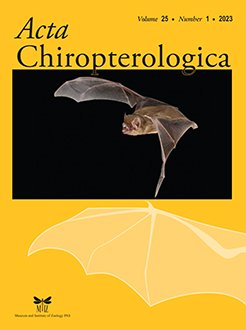Content:
Karyotype Evolution in Vespertilionoidea: Centromere Repositioning and Inversions in Molossidae (Chiroptera, Mammalia)
Marianne Volleth, Klaus-Gerhard Heller, Christopher Tidemann, Hoi-Sen Yong, Martin Göpfert, Stefan Müller
https://doi.org/10.3161/15081109ACC2023.25.1.001
KEYWORDS: Cytotaxonomy, chromosomal evolution, bat phylogenetics
Karyotype Comparison of Five African Vespertilionini Species with Comments on Phylogenetic Relationships and Proposal of a New Subtribe
Marianne Volleth, Frieder Mayer, Klaus-Gerhard Heller, Stefan Müller, Jakob Fahr
https://doi.org/10.3161/15081109ACC2023.25.1.002
KEYWORDS: Nycticeinops macrocephalus, Nycticeinops eisentrauti, chromosomal homology, COI, RAG2
The Late and the Latest Pleistocene Chiroptera (Mammalia) from Loutra Almopias Cave a (Pella, Macedonia, Greece)
Pavlos Piskoulis, Evangelia Tsoukala
https://doi.org/10.3161/15081109ACC2023.25.1.003
KEYWORDS: Vespertilionidae, Miniopteridae, Rhinolophidae, taxonomy, Late Pleistocene, Loutra Almopias Cave A
Abiotic Drivers of Bat Community Diversity in a Savanna Mosaic across the Tropical/Subtropical Transition of South America
Robert D. Owen, Gloria González de Weston, Maria E. Torres, M. Belén Barreto Cáceres
https://doi.org/10.3161/15081109ACC2023.25.1.004
KEYWORDS: Important Bat Conservation Areas, Open Diagonal, Paraguay, Precipitation, species diversity, taxonomic diversity, temperature, trophic diversity, Áreas Importantes para la Conservación de Murciélagos, Diagonal Abierta, diversidad de especies, diversidad taxonómica, diversidad trófica, Paraguay, precipitación, temperatura
Selection of Maternity Roosts by Evening Bats (Nycticeius humeralis) in a Riparian Forest at the Northern Edge of Their Range
Olivia Münzer, Han Li, Brian Schaetz, Allen Kurta
https://doi.org/10.3161/15081109ACC2023.25.1.005
KEYWORDS: Riparian forest, trees, peripheral population, roost selection, evening bat, Nycticeius humeralis, range edge, maternity roost
Insights into the Natural History of the Nectar-Feeding Bat Lonchophylla mordax (Phyllostomidae), a Data Deficient Species Endemic to Brazil
Eder Barbier, Patricia Pilatti, Enrico Bernard
https://doi.org/10.3161/15081109ACC2023.25.1.006
KEYWORDS: Caatinga dry forest, Chiroptera, ectoparasite load, Lonchophyllinae, nectarivorous bats, nocturnal activity pattern, reproductive cycle, Caatinga, carga de ectoparásitos, Chiroptera, ciclo reproductivo, Lonchophyllinae, murciélagos nectarívoros, patrón de actividad nocturna
High Bat Fatality Rates Estimated at Wind Farms in Southern Spain
Sonia Sánchez-Navarro, David Gálvez-Ruiz, Jens Rydell, Carlos Ibáñez
https://doi.org/10.3161/15081109ACC2023.25.1.007
KEYWORDS: mitigation, Wind energy, new fatality estimator, bat conservation, fatality search, search-efficiency, search surface, Nyctalus lasiopterus
Wildlife Use of Anthropogenic Structures: A Comprehensive Review of Bridge Use by Bats
Logan W. Detweiler, Riley F. Bernard
https://doi.org/10.3161/15081109ACC2023.25.1.008
KEYWORDS: roosts, Chiroptera, habitat selection, ecological sink, synanthropic, bridges
Alopecia in Bats: A Case Study of Four Species from Mexico
Itandehui Hernández-Aguilar, Antonio Santos-Moreno, Consuelo Lorenzo
https://doi.org/10.3161/15081109ACC2023.25.1.009
KEYWORDS: Alopecic syndrome, hair loss, Mormoopidae, Phyllostomidae, sindrome alopecico, pérdida de pelo, Mormoopidae, Phyllostomidae
Assessing Age Related Cranial Characteristics and Morphometrics of the Egyptian Rousette (Rousettus aegyptiacus) from Central Africa
Tlaishego T. Nkoana, Teresa Kearney, Wanda Markotter
Open Access: https://doi.org/10.3161/15081109ACC2023.25.1.010
KEYWORDS: age, growth, postnatal, Morphometrics, development, Rousettus aegyptiacus
Acoustic Lures Increase the Effectiveness of Catching Rare and Endangered Forest-Edge and Forest-Interior Bats
Ian Davidson-Watts, Colin F. J. O’Donnell
https://doi.org/10.3161/15081109ACC2023.25.1.011
KEYWORDS: threatened species, New Zealand, lures, Chalinolobus, long-tailed bat, Mystacina, short-tailed bat, harp traps
Wing Tattoos: A Cost-Effective and Long-Lasting Method for Marking Bats
Wanda Markotter, Low De Vries, Janusz Paweska
https://doi.org/10.3161/15081109ACC2023.25.1.012
KEYWORDS: Chiroptera, marking, tattoo, PIT tag
Website: https://bioone.org/journals/acta-chiropterologica/volume-25/issue-1

